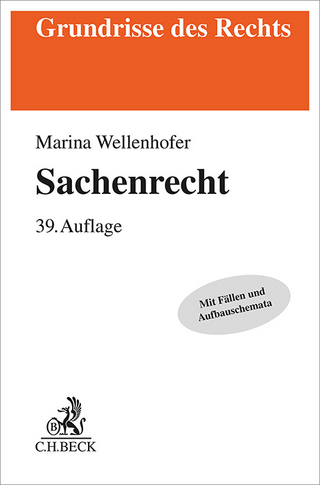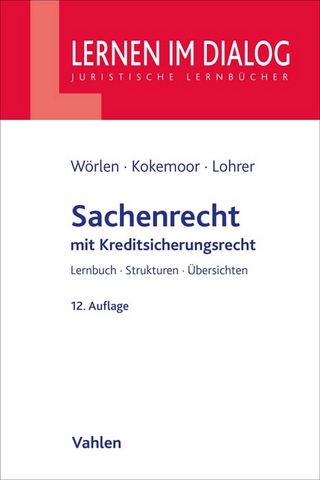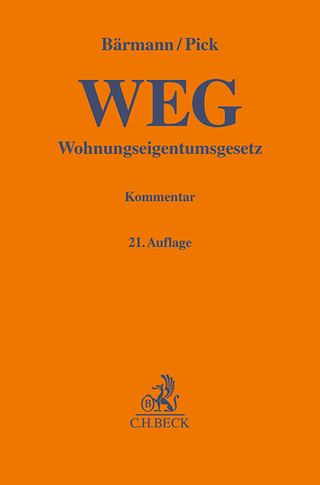
The Law of the Manor
Wildy, Simmonds and Hill Publishing (Verlag)
978-0-85490-305-4 (ISBN)
The Law of the Manor now in its third edition, is the definitive work on the subject. The author provides detailed and comprehensive coverage for practitioners. Those owning, managing, selling, or buying historic houses and estates will also find the book of value; delivering as it does a modern description of the law associated with lordships of the manor.
Principally concerned with the lands and rights of lords, the book also considers rights that can be claimed against them. These are put in context with a discussion of associated topics such as franchises and titles of nobility.
This new edition has been substantially revised. There is a new chapter on the Land Registration Act 2002 and extended coverage of manorial mineral and sporting rights, of roadside verges and of the lost ways which are expected to lose public status in 2031. The book takes account of the House of Commons Justice Committee Report in 2015. It considers several recent cases including Wynne-Finch v Natural Resources Body for Wales [2021] EWCA Civ 1473, R (Littlejohns), v Devon County Council [2016] EWCA Civ 446, Southwark Borough Council v Transport for London [2018] UKSC 63, and R (Strack) v Secretary of State for Environment, Food and Rural Affairs [2024] EWCA Civ 420.
New material has been included on the conversion of waste of the manor to occupied land, roadside verges and town and village greens. There is also greater coverage of legal authorities including over fifty decisions since the first edition and a selection of useful precedents for the practitioner.
The text is arranged in five parts. Part 1 describes the context, summarises the history and analyses custom which is the basis of manorial law. Part 2 describes the lands of tenants and lords and the relations between them. Part 3 discusses rights and comprises a detailed commentary on section 62(3) of the Law of Property Act 1925. The book covers rights of common, mineral, and sporting rights, courts and remaining revenues. Part 4 sets the manor in the context of other institutions, namely the church, towns and feudal relationships. Part 5 summarises and looks at the modern manor, its documents, conveyancing (with particular reference to registered land) and taxation, concluding with suggestions for reform.
Christopher Jessel joined Farrer & Co in 1967 and retired as a partner in 2008. He has practiced in rural, constitutional and charity law and is the author of several legal textbooks.
Preface to Third Edition
Introduction
Principal Sources
Table of Statutes and Other Laws
Table of Statutory Instruments
Table of Cases
List of Abbreviations
Glossary
PART I - ROOTS
1 Description and History
1.1 The manor as an idea and a place
1.2 Domesday Book and after
1.3 Farmland
1.4 Buildings
1.5 Waste and outliers
1.6 Size
1.7 Variety
1.8 Manor and village
1.9 Decline
2 Custom
2.1 Custom and the manor
2.2 Local
2.3 Ancient and continuous
2.4 Reasonable
2.5 Certain
2.6 Services
2.7 Inheritance and disposition
2.8 Enjoyment
2.9 Extinction of custom
PART II - LANDS
3 Freehold and Copyhold
3.1 Nature of copyhold
3.2 Tenure
3.3 Certain and uncertain tenure
3.4 Free and unfree tenure
3.5 Common and customary tenure
3.6 Surrender and admittance
3.6.1 Title to copyholds
3.6.2 New copyholds
3.6.3 Leases of copyholds
3.6.4 Acquisition of copyhold by lord
3.7 Enfranchisement
3.7.1 Common law enfranchisement
3.7.2 Statutory enfranchisement 1841 to 1925
3.7.3 The Law of Property Act 1922
3.7.4 Preserved rights
3.8 Tenures today
4 The Lands of the Lord
4.1 Demesne and other land
4.2 Management and leases
4.3 Waste and commons registration
4.3.1 Meaning of waste
4.3.2 The Commons Registration Act 1965
4.3.3 The Commons Act 2006
4.4 Types of waste
4.5 Balks
4.6 Unclaimed land of unknown lords
4.6.1 Title
4.7 Loss of waste
5 Parcels and Escheat
5.1 Limits of the manor
5.2 Outliers and distributed lands
5.3 Subinfeudation and Quia Emptores 1290
5.4 Rule against enlarging manor
5.5 Rule against land reverting to manor
5.6 Escheat
5.6.1 Former copyhold land
5.6.2 Escheat as reverter
5.6.3 Operation of escheat
6 Inclosure
6.1 Nature of inclosure
6.2 Unilateral inclosure
6.2.1 Approvement and assarting
6.2.2 Commonable fields
6.2.3 Adverse possession
6.3 Inclosure by agreement
6.4 General statutory inclosure
6.5 Piecemeal statutory inclosure
6.6 Private and public rights
6.7 Hedges in inclosure acts
7 Legal and Reputed
7.1 Creation and acquisition of manors
7.2 Proving the manor
7.3 Division by operation of law
7.4 Dissolution
7.4.1 Loss of lordship
7.4.2 Loss of tenants
7.4.3 Separation
7.5 Reputed manors
PART III - RIGHTS
8 Manorial Rights
8.1 Rights and the manor
8.2 Corporeal and incorporeal
8.2.1 Incorporeal hereditaments
8.2.2 The Law of Property Act 1925 s 62(3)
8.3 Property and possession, substance and revenue
8.4 Incidents, appurtenances and other rights
8.5 Manorial or seigniorial rights
8.5.1 In general
8.5.2 In inclosure acts
8.5.3 On enfranchisement
8.5.4 Profits and easements
8.6 Conclusion
9 Commons and Greens
9.1 Common land
9.2 Background to reform
9.3 The current legislation
9.3.1 The Commons Registration Act 1965
9.3.2 The Commons Act 2006
9.4 Creation, acquisition and extinction
9.4.1 The old law
9.4.2 The modern law
9.5 Common and related rights classified
9.5.1 By content of right
9.5.2 By entitlement
9.5.2.1 Legal
9.5.2.2 Customary
9.5.2.3 Contractual
9.5.2.4 Tolerance
9.5.2.5 Equitable
9.5.2.6 Quantification
9.5.3 Lot meadows and regulated pastures
9.5.4 By benefit
9.5.4.1 Appendant
9.5.4.2 Appurtenant
9.5.4.3 In gross
9.5.4.4 Pur cause de vicinage
9.6 Commonable rights
9.7 Rights of the lord
9.8 Regulation
9.9 Public access and conservation
9.9.1 Early statutory access
9.9.2 The Countryside and Rights of Way Act 2000
9.10 Town and village greens
9.10.1 Greens under local acts
9.10.2 Traditional greens
9.10.3 Modern greens
9.10.4 Local and as of right
9.11 Management of greens
10 Roads and Paths
10.1 Ownership of roads and ways
10.1.1 Common law
10.1.2 Copyholds
10.1.3 Inclosure acts
10.1.4 General acts
10.1.5 Rights and duties
10.1.6 Roadside verges
10.1.7 Liability for trees
10.2 Maintenance and tolls
10.2.1 Common law
10.2.2 Statute
10.2.3 Private roads
10.3 Summary on ownership and maintenance of roads
10.4 Routes across common land
10.5 Lost ways
10.6 Customary ways and churchways
10.7 Bridges
11 Minerals and Timber
11.1 Rights to wood and minerals
11.2 Trees
11.3 Estovers, botes, furze and turbary
11.4 Tenants’ mineral rights in the waste
11.5 Express, customary and nationalised rights
11.5.1 Meaning of minerals
11.5.2 Nationalised minerals
11.6 Ownership of void
11.7 Lord’s minerals in owned or disposed land
11.7.1 Demesne
11.7.2 Uninclosed waste
11.7.3 Inclosed waste
11.7.4 Shares in external land
11.8 Annexures and appurtenances
11.9 Copyhold land
11.9.1 Nature of copyhold minerals
11.9.2 Rights of access and working
11.9.3 Shall not affect
11.9.4 Exceptions on enfranchisement
11.10 Conclusion
12 Sporting
12.1 Sporting and wild animals
12.2 Forest, chase and park
12.3 Free warren
12.4 Sporting in copyhold land
12.5 Sporting on demesne and uninclosed waste
12.6 Sporting on inclosed waste
12.7 Hunting
12.8 The Game Laws
12.9 Conclusion
13 Waters and Fishing
13.1 Rivers
13.2 Foreshore and seabed
13.3 Fishing
13.3.1 Inland waters
13.3.2 Tidal waters
13.3.3 Statutory fisheries
13.4 Ports and harbours
13.5 Anchorage and mooring
13.6 Ferries
13.7 Wreck
14 Courts
14.1 Courts baron and customary
14.2 Courts leet
14.3 Hundred courts
14.4 Time and place
14.5 Procedure
14.6 The Administration of Justice Act 1977
14.7 Officers
15 Rents and Revenues
15.1 Nature of manorial revenues
15.2 Court payments
15.3 Reliefs and heriots
15.4 Transmission fines and royalties
15.5 Rentcharges and rents seck
15.6 Rentservices – chief, assize, quit and fee farm
15.7 Wayleaves
15.8 Tolls
16 Franchises
16.1 Nature of franchises
16.2 Types of franchise
16.2.1 Palatinates
16.2.2 Treasure
16.2.3 Royal mines
16.2.4 Courts
16.2.5 Liberties
16.2.6 Waifs
16.2.7 Deodands
16.2.8 Animals, birds and fish
16.2.9 Goods of suicides
16.2.10 Created rights
16.2.11 Legal personality
16.3 Creation and extinction
16.3.1 Creation
16.3.2 Presumed grant
16.3.3 Extinction
16.3.4 Merger in Crown rights
17 Miscellaneous Rights
17.1 Seigniorial rights
17.1.1 Mills and mulctures
17.1.2 Ale and ovens
17.1.3 Maiden right
17.2 Appointments
17.3 Covenants
17.4 Works
17.5 Ceremonial renders
18 Fealty and Protection
18.1 Homage and fealty
18.2 Allegiance
18.3 Warranty
18.4 Grand and petty sergeanty
19 Parish and Church
19.1 Manor and parish
19.2 Advowsons
19.3 Appropriate and impropriate rectories
19.4 Chancel repairs
19.5 New church buildings on common land
19.6 Glebe and other land
19.7 Rectorial manors
19.8 Consecrated land
19.9 Churchways
19.10 Schools
19.11 Tithe, modus and corn rents
19.12 Frankalmoign and episcopal property
20 Towns and Trade
20.1 Towns and boroughs
20.2 Markets
20.3 Open places and streets
20.4 Houses
20.5 Corporations, trusts and charity
21 Fees, Honours and Estates
21.1 Feudalism
21.2 Derivative titles to land
21.3 Honours
21.4 Knights’ fees and feudal incidents
21.5 Complications of tenure
21.6 Legal estates
21.7 Landed estates
22 Lords and Titles
22.1 Hereditary peers
22.2 Life peers
22.3 Knights, gentlemen and honourable
23 Royal Demesne
23.1 Crown estate
23.2 Royal residences and parks
23.3 Purprestures
23.4 East Greenwich and other lordships of sold lands
23.5 Registration of title to royal demesne
23.6 The Royal Duchies
23.7 Parliamentary manors
23.8 Ancient demesne
23.9 Changes affecting royal manors
24 Beyond England
24.1 Wales
24.2 Scotland
24.3 Ireland
24.4 North America
PART V - CONCLUSION
25 Rolls and Unregistered Title
25.1 Evidence of rights
25.2 Manorial rolls
25.3 Other manorial documents
25.4 Ownership and custody
25.5 Title deeds
26 Registered Land
26.1 General principles
26.2 Land
26.3 Manors
26.4 Rentcharges
26.5 Franchises
26.5.1 Registration with its own title
26.5.2 As overriding interest
26.6 Customary and public rights
26.6.1 Public rights
26.6.2 Customary rights
26.6.3 Town and village greens
26.7 Easements and profits
26.7.1 Rights of common
26.7.1.1 In general
26.7.1.2 Registered before 1965
26.7.2 Easements and profits under inclosure acts or on enfranchisement
26.7.3 Transitional provisions for land registered before 2003
26.7.4 Land first registered after 2003
26.7.5 Registrable profits in gross
26.7.6 Rights of way over downgraded or former highways
26.8 Ancient rights
26.8.1 The pre-2003 law
26.8.2 The Land Registration Act 2002 transitional provisions
26.8.3 Priority
26.8.4 Transitional non-manorial rights
26.9 Manorial rights
26.9.1 Meaning within the Land Registration Act 2002
26.9.2 Entering on the register
26.9.3 The Justice Committee report
26.10 Transitional rights after 2013
26.11 Human rights
26.12 Minerals
26.12.1 Exceptions and grants of strata
26.12.2 Associated rights
26.12.3 Profit of minerals
26.12.4 Lord’s rights in enfranchised land
26.13 Escheat
26.14 Conveyancing and disputes
26.14.1 Duty to disclose
26.14.2 Information
26.14.3 Old cautions
26.14.4 Disputes
27 Buying and Selling
27.1 The market in manors
27.2 Agents
27.3 Lawyers
27.4 Title
27.5 Terms and conditions of sale
27.6 Taxation
28 Definition
28.1 Jurisprudence of the manor
28.2 Philosophy
28.3 Historical understanding
28.4 Ownership and public law
28.5 Whether the manor is land
28.6 Conclusion
Appendices
1 Precedents
2 Extracts from Statutes
Index
| Erscheinungsdatum | 05.10.2024 |
|---|---|
| Verlagsort | London |
| Sprache | englisch |
| Maße | 152 x 229 mm |
| Gewicht | 1000 g |
| Themenwelt | Recht / Steuern ► EU / Internationales Recht |
| Recht / Steuern ► Privatrecht / Bürgerliches Recht ► Sachenrecht | |
| ISBN-10 | 0-85490-305-4 / 0854903054 |
| ISBN-13 | 978-0-85490-305-4 / 9780854903054 |
| Zustand | Neuware |
| Haben Sie eine Frage zum Produkt? |
aus dem Bereich


